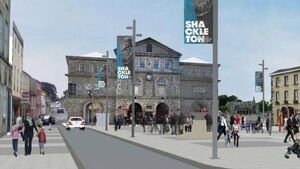Rejuvenation of Athy needs to be driven by partnership

Artist image of what redeveloped Emily Square and Shackleton Museum
Revitalise, rejuvenate, redevelop, refurbish. These were some of the words in the ether in the Clanard Court hotel on Tuesday last.
The hotel was the venue for the launch, by Kildare County Council, of the ‘Athy Building Enhancement Financial Scheme’.
While I normally have an aversion to buzz words and grandiloquent project titles the county council’s plans for the ongoing development and improvement of Athy are impressive and heartening.
The evening began with a three-minute montage video produced by the council focusing on the town and its attributes narrated by our own Jack L.
It was a timely reminder of the many attractions of the town and the significant development that has occurred here in the last ten to fifteen years.
There was a natural focus on the now to be named ‘Shackleton Experience’ (formerly the Shackleton Museum) which I understand will be opening at the end of the summer. The projected visitors for the first year are 30,000 per year, rising to 60,000 per year over the next few years.
The video was followed by a presentation by a Simon Wall who is a senior architect with Mayo County Council. He has been to the forefront of the rejuvenation of Westport over the past 25 years and his presentation was an informative insight into the targeted, yet holistic, approach to improving the built environment in a small country town, making it more attractive for both visitors and for the community who live there. There is no doubt that the enhanced works currently taking place in Emily Square and the refurbishment of the museum are going to lift the town in both a social, cultural and economic sense.
It was heartening to see such a significant representation of local businesses at the presentations and there is a ‘buy in’ from the local business community. It does, however, behove all the business owners to meet the challenges of the development of the town with purpose and innovation.
We can’t rely entirely on Kildare County Council to give the town the much-needed economic fillip which these enhancements can help deliver.
A lot of the enhancements now being proposed/promoted by Kildare County Council build on the regeneration strategy that was initiated in 2015 with the support of local bodies such as the Athy Lions Club, the Leader Partnership, Athy Enterprise Centre and Kildare Chamber of Commerce.
A key part of any development strategy has to be the provision of residential properties in the heart of the town. I understand that a government grant is on the way in relation to assisting shop owners to redevelop the upper stories of their town centre properties to provide residential accommodation.
This is a much-needed addition to the depleted housing stock in the town. As recently as the 1980s many shop owners lived above their premises, and this is an under-utilised resource which needs to be accessed. All these improvements will be driven by a partnership between our local authority and the town community.
Improvements have always driven Athy’s development. We take for granted the provision of water in our domestic settings, but Athy only received its first piped water scheme in 1907.
Work on the scheme commenced in October 1906 and was completed in April 1907. How many modern infrastructural projects can boast such a short time frame!
Following the successful completion of Athy’s first water scheme the Metropolitan Drinking Fountain and Cattle Trough Association presented two troughs to the town in 1907, one placed in Woodstock Street opposite Higginson’s Lane, the other in Leinster Street (where it remains to today).
At the same time the Duke of Leinster presented a fountain for the use of the people of Athy which was positioned at the front of Emily Square and that self-same fountain was temporarily removed from the square during the current improvement works, but as I understand it will be returning to its original position with the completion of the works in or about June of this year.
Horse troughs met a basic but very necessary need for the many horses which passed through the streets of Athy in the 19th century. The Metropolitan Drinking Fountain and Cattle Trough Association, the equivalent of the modern SPCA., provided water troughs at the roadsides for use by horses, cattle and other animals.
Charles Dickens Junior, in his Dickens’ Dictionary of London in 1879, wrote of the fountains provided by the Association in London that a single trough supplied the wants of 1,800 horses in one 24-hour period.
Horses are long gone from our streets but their replacement, the motor vehicle, has for too long dominated our public spaces and the re-ordering of Emily Square marks a welcome return to its proper purpose as a civic space and amenity to be enjoyed by all.






